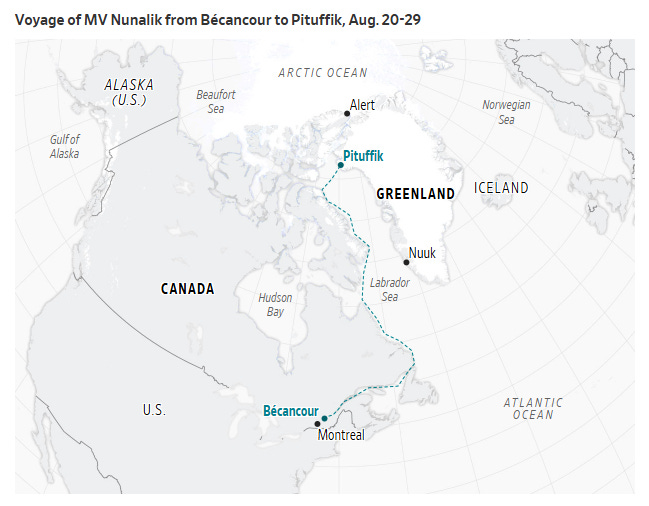Canada’s Industrial Blind Spot, America’s Talent Offensive
The Icebreaker heads to Parliament to Testify
Next week, The Icebreaker will appear as an expert witness before the House of Commons’ Standing Committee on Industry and Technology, in the context of its study of a Defence Industrial Strategy. We will testify on the results of our national dual use mapping survey. The Americans are simultaneously reimagining their defence industrial base (🔉 In-Q-Tel podcast).
🎯 Three-Shot Burst
Troy Crosby (former ADM(Mat)), argues that Canada’s defence procurement system urgently needs to shift from the traditional “fair, open, and transparent” RFP competition model toward a more “strategic, fair, and transparent” approach tailored to national interests and security.
Risk profile: The US ITAR regime shows how IP controls are central to defence technology. Crosby argues Canada must focus on licensing sufficient technical data and operational rights, not outright IP ownership, to sustain and upgrade systems efficiently. Ownership demands can kill deals and add major cost, but without strong licensing or access, Canadian forces and industry risk vendor lock-in.
How it works: Crosby explains that competition for its own sake—mandated by trade agreements—often conflicts with the needs of classified and sensitive defence programs, where true openness can undermine security or strategic leverage. Recent regulatory amendments now allow for more targeted procurements using national security exceptions, meaning authorities can limit competition to select suppliers and bypass typical public disclosure when warranted.
Openness is not always the right answer for defence acquisition. Using national security exceptions and negotiated RFPs enables government to act with strategic purpose, balancing transparency with real-world security needs
Bottom line: Canada to develop a defence industrial strategy that puts strategic outcomes first: targeted procurement using exceptions when necessary, aggressive licensing of technical data, and direct support for domestic innovation. Procurement should be a mechanism for strategic partnership with Canadian innovators, not just a process for buying foreign systems.
Related:
Industry shows ‘cautious optimism’ with new procurement agency, but ‘government needs to deliver’… Canada has tapped an RBC exec to lead the agency
Bargaining power: Will Canada acquire a mixed fleet of fighter jets? Not everyone thinks that would be a good idea… It’s ‘full steam ahead’ for the F-35 program until told otherwise, defence official says
Shifting sands: Efforts to revise Canada’s national security strategy hit a snag when it became clear earlier this year that many of the assumptions underlying the work were “no longer valid,” a newly released memo reveals
ADVERTISEMENT
Dominion Dynamics is hosting an event in Ottawa tomorrow titled “Building a Defence Tech Ecosystem in Canada”.
🤝 Sovereign Capability
The United States is stealing Canada’s future, and nobody seems to notice
State of play: In the AI economy, value is being created not just by established players, but by individual talent, pre-company, pre-product and pre-revenue. That’s the race Canada risks losing.
As we focus on building infrastructure systems and education strategies similar to those the Americans used to win over the last three decades, U.S. investors are already deploying their newest strategy: investing in top AI talent before they have a company, product or sometimes even before they have an idea.
What’s next: In the defence space, the US is already focused on the next playing field, and won’t just rely on primes and neo-primes alone but a healthy pipeline of tech startups, says Morgan Hitzig, a partner at Venrock, focusing on early stage investments particularly in security startup:
Related:
A short history of the Helsinki Shipyard being brought back under Western control to produce icebreakers
Making the grade?:
✅ Canada remains a leader (13th) in innovation inputs, on the strength of our institutions (15th), quality education and R&D (10th), market sophistication (8th) and late-stage VC (8th). The country also has 3 innovation clusters in the top 100, and strong industry-university collaboration (6th)
❌ The familiar flip side is that Canada ranks 20th in innovation outputs, with poor performance notably in productivity growth (101st!), industrial designs (95th), trademarks (85th), and “knowledge diffusion” (41st) which is a basket of commercialization metrics
One of the world’s biggest AI companies wants a deal with Canada. Is sovereignty the trade-off?… Canadian cloud providers unite to launch sovereign cloud offering for government
Canada eyes putting nuclear reactors on the moon
IDEaS program wants your R&D solutions that connect space-based systems through advanced communication gateways… innovators are on site at CFB Gagetown to demonstrate and test cutting-edge technologies designed to help the military safely maneuver through complex, heavily-defended minefields… Ottawa has selected 20 innovators to show us their latest innovations at the 2025 Urban Counter Uncrewed Aerial Systems Sandbox event
ADVERTISEMENT
⚔️ Combat Readiness
Defend the Arctic: Aboard a Canadian military supply ship drifting in a blizzard
The West is racing to catch up with Russian and Chinese expansion in the Arctic, one of the world’s most contested places, in a new era of geopolitical conflict.
Defending the Arctic—an environment that for centuries has thwarted ambitions of explorers and governments—will demand big budgets, unprecedented resources and determination. Even the most basic elements of operating a military base in the high Arctic are extremely cumbersome.
In a sign of how daunting Arctic operations can be, the Nunalik’s cargo wasn’t even destined for Greenland. From Pituffik, a plane would carry it farther north to Alert, a Canadian signals intelligence outpost only 500 miles from the North Pole—roughly the distance between New York and Detroit—and unreachable by cargo ship. A Canadian official said if anything was missing from the cargo, it could delay construction on the base by a year, until the next sealift.
Related:
Drop in Ukraine’s ballistic missile intercept rate — from 37 to 6 percent — what happened?
Without saying ‘Golden Dome,’ McGuinty touts U.S. missile defence co-operation… Canada has been working for years to prepare for Golden Dome, Air Force general says
Canada and Germany talk maritime drones as Europe worries about threats to undersea infrastructure
The new AI arms race changing the war in Ukraine… How and Why Ukraine’s Military Is Going Digital… How Ukraine turned the tables on Russia… Europe’s drone wall: A plan to sabotage Russia’s air incursions
With the U of A as a trusted partner, Lockheed Martin taps into a wealth of technical expertise
Foreign adversaries are using multiple AI tools to power hacks: OpenAI
Visit the Canadian Armed Forces Cyber Command (CAFCYBERCOM) and the Communications Security Establishment’s Canadian Center for Cyber Security (CCCS) booths at the INCYBER Forum Canada today and tomorrow (14-15 October) at the Palais de Congrès in Montreal
ADVERTISEMENT
Our comprehensive course provides an in-depth overview of the Canadian federal procurement process.
🍁 Investor Corner
Mark Maybank on Lessons from Allies: How the US, Israel, and Europe Invest in Dual-Use Innovation
Is it too late to get into defence investing? Perhaps in public markets. But in private, it looks like the beginning of a multi-decade transformation
Stoke Space raises $510M in Series D funding to scale manufacturing of reusable launch vehicle
HavocAI raises $85M to sell autonomous boats to the U.S. military
Forterra acquires goTenna: “By integrating goTenna technology into our platform, we’re improving user experience in controlling and interacting with robots in operational environments and eliminating communication concerns, especially in denied environments where traditional systems fall short,” Forterra CEO Josh Araujo said
Epirus and General Dynamics Team Up on c-UAS Robotic Ground Vehicle
Spain’s Santander: It’s time banks invested in weapons
B. Riley Securities’ 3Q25 Aerospace & Defence Update
Why National Security and Defence Veterans Can Excel in European Venture
Golden Defence Awards recognizes 50 US military leaders driving innovation in defence community
🔫 Hot Shots
Rare earth squeeze: In a rare move, the Dutch government has invoked an emergency Cold War-era law to take control of Nexperia, a Chinese-owned chipmaker based in the Netherlands… China’s rare earth controls target not just defence companies, but ‘forbid any country on Earth from participating in the modern economy’… Rare Earth Stocks Surge On JPMorgan’s $1.5 Trillion U.S. Investment Pledge… More than 78 percent of the U.S. military’s weapons rely on Chinese materials… Critical minerals — the new gold rush?… Scientists Have Discovered the Pathway to Element 120—the Holy Grail of Chemistry
The real China playbook: Beijing pairs targeted subsidies with massive investments in electricity, digital networks, transport, and a 70‑million‑strong industrial workforce to enable rapid iteration and global dominance in EVs, solar, batteries, and AI. The result: resilient technological momentum despite waste, corruption, and weak domestic demand.
A Globe & Mail op-ed argues that the recent move by Washington to invest in Canadian mining companies represents a significant national-security dilemma for Ottawa. Ditto a CBC piece, and another in Bloomberg. Does framing American investment in Canada’s critical minerals as a ‘national concern’ create a false equivalency about foreign adversaries state-linked mining ownership, which is already pervasive in Canada?
How the CCP Gets its Key Equipment for Making Semiconductors from U.S., Dutch, and Japanese Companies.
Dual Use: The question of military spending’s externalities requires a strong analytical foundation which clearly situates the military’s role within the political-economy. Mark Robbins’ ten year old paper is worth a read on this topic… When civil society powers defence — a Canadian author on Ukraine’s interceptor drones… BRP’s vehicles in sights of NATO countries boosting military spending, company says… Rheinmetall reaches agreement with Lürssen Group on acquisition of NVL
At the edge: NASA’s Voyager 1 Revealed a Stunning Discovery At The Edge Of Our Solar System… Kongsberg Geospatial and NordSpace have signed an MOU to collaborate on advancing Canada’s responsive sovereign space launch and range safety capabilities… Sovereign launch is coming for Canada:
Here and there: Drone plot against Belgian PM foiled… Australia’s spy chief warns world now in ‘grey-zone warfare’… US Cyber Command head says China’s capacity to hack the U.S. is growing — that includes non-military targets like law firms… China is definitively winning the cyber war… A pro-Russian hacker group has been caught boasting about a cyberattack that unfolded entirely inside a decoy system set up by researchers… Defence contractor Calian appoints new CEO as it nears end of internal review
If you’ve got battlefield intel, classified tips, or just want to call in an airstrike on our typos, hit “reply” and sound off. Whether it’s a new tech sighting, a rumour from the mess hall, or feedback on our comms, we want your SITREP.








Timely and insightful as usual.